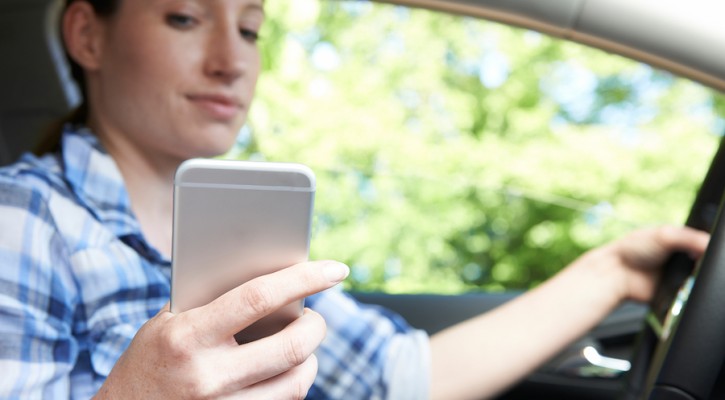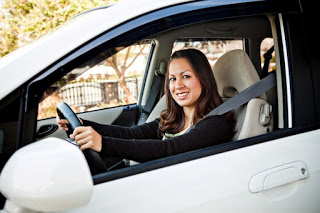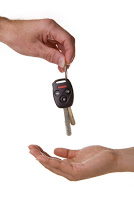Tag Archive: texting and driving

Some Teen Safe Driving Choices Are Still Dangerous
December 17, 2015
Researchers at the Children’s Hospital of Philadelphia recently conducted a study to gauge teen attitudes on safe driving choices regarding cell phones. The researchers saw some encouraging signs but say there’s still a long way to go before cell phone use by teens while driving is a thing of the past.
To conduct their research, the researchers conducted several focus groups with 16 to 18 year old drivers. The questions asked of the teen drivers were designed to get an overall view of teen perceptions regarding cell phone use while driving with the intent of gathering information to help develop future interventions to reduce risky driving choices by teens.
According to the head researcher, Catherine McDonald, PhD, RN, it was encouraging to see that teens recognized that cell phone use, texting, and use of social media are dangerous behind-the-wheel. When asked what methods teens used to prevent the use of cell phones while driving, some teens listed methods such as turning off the cell phone or pulling off the road before making or answering a call. However, some teens listed choices such as waiting for a red light or until they were on familiar roads before diverting their attention to the cell phone.
While it’s good that they are considering ways to reduce their cell phone use, those choices such as waiting for red lights or familiar roads are still dangerous choices that take their eyes and mental attention off the road.
- Choosing to use hands-free communication devices has been shown to be no safer than the use of hand-held devices.
- A driver’s attention at red lights is important too. Not noticing that the light has turned green can hold up traffic behind and lead angry drivers to try to retaliate.
- Research shows that hands-free devices are still distracting for up to 27 seconds after hanging up.
- Waiting for familiar roads is a bad choice because most traffic collisions happen within 25 miles of home and at speeds below 45 mph. Drivers become complacent on those familiar roads and that leads to even more distractions.
According to the researchers, until more effective methods are developed to pry teens away from their cell phones while driving, parents are still the primary influence in promoting safer choices by teens. Setting a good example and insisting on strict rules for cell phone use while driving, parents can help keep their teens safe on the road.

Commit to Being a Safer Driver
April 10, 2012
Many people will make a commitment to losing weight, to do better in school, get out of debt, or join a fitness club. The sad part of making these resolutions is they are often very hard to keep and people often fail within the first few weeks or months of trying. One resolution that is easy to keep is to become a safer driver. It’s easy to achieve because licensed teenage drivers are in their vehicles every day giving them the opportunity to practice safe driving habits.
In today’s world of driving, drivers are trying to multitask behind the wheel with negative results. According to the Boston Focus Group Study of Bad Drivers:
- 77% of drivers admit to talking or texting while driving
- 60% admit to eating while driving
- 50% admit to making obscene or rude gestures or comments to other drivers, particularly those who cut in front of them
- 50% admit to almost falling asleep while behind the wheel
- Countless teens are getting behind the wheel of their vehicle drunk, high or buzzed.
Making a commitment to eliminate those types of activities from your daily driving habits isn’t hard to do. Let’s look at a few more:
- Ditch the cell phone because using a cell phone or texting while driving can be as dangerous or deadly as drunk driving. One way of doing this is to keep your cell phone far enough away that you will not be tempted to use it. Keep it turned off and let all messages go to voicemail. You can also purchase a cell phone blocker to block calls and/or texts while the vehicle is in motion. Only use a cell phone when driving for emergencies.
- Drive within the posted speed limit. When you speed you are increasing your chances of getting into a crash, injuring or killing yourself or others. Don’t be a follower and speed just because you think everyone else does. Be a leader and show others you obey the law.
- Fast food is often a teens lifeline but not while you are driving. If you need a snack, go into the restaurant or park and eat and then continue your journey.
- Always look when entering a lane of traffic or passing another car. Get into the habit of using your turn signals and side-view mirrors and don’t forget those inexpensive “blind-spot mirrors” can make the difference of getting into a crash or not.
- When someone cuts you off, take a deep breath, count to ten and let it go. Road rage accomplishes nothing except putting you in danger of a crash while you try to catch up to the other driver.
- Wear your seatbelt. Not because it’s the law, but because it will save your life.
- Study for your school tests at home, not while driving to school. Reading while driving is the second most common distraction while driving after the cell phone.
- Always remember drinking and drugged driving don’t mix. One beer even some over-the-counter medications can negatively impact your driving skills.
- If you plan on partying with alcohol, make sure you use a designated driver. Also remember that the drinking age is 21 in all 50 states.
- Finally, take a defensive driving course every couple of years. It’s always good to have a little refresher course and find out what changes have been made in the traffic laws and road conditions.
Make a commitment to become a smarter and safer driver. It is easy to incorporate into your daily living and will help you survive on the road. DRIVE SAFE!

Study Shows Teens with Their Own Car Have More Crashes
February 16, 2012
Two studies published in 2009 showed that teens who had to share a car and whose parents who were involved in their driving in a supportive way were far less likely to be involved in a crash or to engage in risky driving behaviors.
The studies, conducted by Children’s Hospital of Philadelphia (CHOP) and State Farm Insurance, were published in the October 2009 issue of Pediatrics. According to a news release by State Farm Insurance, the studies were based on a National Young Driver Survey of more than 5,500 teenagers in grades 9 through 11.
The first study showed that “teens who said their parents set clear rules, paid attention to where they were going and whom they were with, and did so in a supportive way were:
- half as likely to crash
- twice as likely to wear seat belts
- 71 percent less likely to drive while intoxicated
- 30 percent less likely to use a cell phone while driving
These findings are compared to teens who said their parents were less involved.”
The second study looked at teens who either owned their own car or had easy, unrestricted access to a car were twice as likely to be involved in a crash. The study showed that almost 75% of teen drivers owned or had unrestricted access to a car. 25% of teens who were the main driver of a car reported having been involved in a collision compared to just 10% of those who had to borrow a car.
On a basic level it makes sense; a teen that has to borrow a car faces the wrath of the owner if that car is damaged or destroyed. Teens who own their own car don’t feel that sense of responsibility to protect someone else’s property from harm.
These studies show the critical importance of parental involvement in a teen’s driving environment and add to data that shows Graduated Drivers Licenses for teens work to create a safer driving environment for teens.
Car crashes are the main cause of death for teenagers in the United States. According to the National Highway Traffic Safety Administration (NHTSA), teens are involved in three times as many fatal traffic crashes as all other drivers.
NHTSA figures for 2009 show:
- Traffic crashes are the leading cause of death for 15 to 20 year olds.
- 5,148 15- to 20-year-old drivers were involved in fatal crashes.
- 2,336 15- to 20-year-old drivers were killed.
- 196,000 15- to 20-year-olds were injured in motor vehicle crashes.
- 15 to 20 year old drivers make up 6.4% of the licensed drivers in the US but they account for 11% of the fatal crashes.
Many parents, especially in those households where both parents work, look forward to the day when they no longer have to transport their teen to various activities. However parents should strongly resist the urge to buy a car for the sole use of the teen; at least for the first year. According to data from the Insurance Institute for Highway Safety (IIHS) the most dangerous time for teens is the first year after receiving their driver’s license. The IIHS states that “the crash rate per mile driven is twice as high for 16 year-olds as it is for 18-19 year-olds.”
“Our data show that one of the safest decisions families can make is for parents to control access to the keys for at least the first 6 to 12 months after a teen gets his license,” says Flaura Koplin Winston, MD, PhD, study co-author and scientific director of the Center for Injury Research and Prevention at CHOP. “Our data show an alarming trend – almost three-quarters of teens have easy access to a car. Compared to teens that have to share a car, these teens are twice as likely to crash and more likely to speed and to use a cell phone while driving. When teens have to ask for the keys before taking the car, it naturally creates the opportunity for parents to have conversations with their teens about where they are going, who they will be with, and to review the house rules about driving with passengers, wearing seat belts, using cell phones, and which routes are safe.”
A dialogue should be started with the teen before they receive their learner’s license and an effective tool for setting up those rules and boundaries is the Parent-Teen Driving Contract. When parents and teens both agree on what the rules should be, the teen is more likely to take ownership of that decision.

Texting and Driving: What happens when a vehicle comes in your lane.
January 20, 2012
You can read about it several times a week; a driver who is either texting, using a cell phone, or engaged in some other form of distracted driving, drifts over into the oncoming lane causing a crash. This type of crash is becoming all too common and unfortunately, death is often the result. Head-on crashes are the worst type of crash with the greatest potential for serious injuries and death. However, a driver in your lane doesn’t automatically have to result in a head-on crash if you are prepared.
To be prepared for the unexpected drivers should always use the S.I.P.D.E method of defensive driving. That is:
- Search the driving scene – Always be aware of what is happening in front of you, to the sides, and behind.
- Identify hazards – Be on the lookout for anything that could be a potential hazard whether that be a driver about to pull out of a parking lot or a driver ahead who is obviously distracted and isn’t looking at the roadway.
- Predict what may happen – When trying to predict what the other driver might do, in order to best prepare yourself, always predict the worst thing that could possibly happen.
- Decide what you will do – Having a decision already in mind if that other driver should do the worst will allow you additional precious time to escape a collision situation.
- Execute your decision – If the worst thing happens, you will have to put your plan into action in order to escape a collision.
Note: Sometimes you may not be able to completely escape a collision, when planning and executing your decision, you may have to choose to lessen the crash forces rather than escape a crash altogether.
If a driver ahead should suddenly swerve into your lane, you may have very few choices but, to avoid or reduce the severity of the crash, follow these tips:
- Honk your horn to alert the other driver.
- Don’t try to swerve to the left into his lane to avoid a crash, he may realize what he is doing and try to swerve back into his lane at the same time.
- Rather than face a head-on crash, it is better to go off the road to the right. There may be hazards there too so steer to avoid them and try to quickly slow to a stop. It is better to go into some bushes than to crash into something hard.
- Sometimes you may face the very tough choice of hitting a car on the right to avoid a head-on crash. Hitting a vehicle that is going in the same direction as you, while still very serious, is often safer than facing a head-on crash.

Distracted Driving Campaigns
July 9, 2010
Buzz, buzz…it will just take a second to check. Ring, ring…it could be important. Yeah, I should go ahead and make that call. It will save me the time and hassle later on. The temptation to reach out and/or respond to some one through a cell phone is great. You have heard the news stories and safe driving campaigns and you know that you shouldn’t, but…do you resist the urge to use the cell phone or let temptation get the best of you?
In order to completely eliminate the urge to use your phone you could turn it off before turning your key in the ignition, lock it up (in the glove box, console, or trunk), or install some of the new technology for cell phones. There are several companies offering services that will restrict the phone’s ability to send and receive text and email messages. Some companies offer services that will restrict calls too. A sampling include:
Textecution – http://www.textecution.com
Textecution is an application designed for parents to install on their children’s phones. It utilizes the GPS features of several handsets to determine if the owner of the phone is moving at more than 10mph. It disables the texting function of the phone. If the person with Textecution on their phone is riding a vehicle as a passenger, or in a bus or train need to use the text feature, there is an “override” option — requesting for text access from the administrator. The parent who installed the phone is designated as the administrator, and can allow, temporarily for the phone to allow texting features. www.safefloridadriver.com
iZUP – http://www.getizup.com/
iZUP disables your phone entirely, removing any distraction from the road. It automatically forwards calls to voicemail and holds text messages while the phone is in motion. It is also time-delayed, to prevent reactivation of the phone’s features in natural stopping areas, like stop lights. The phone will only allow the user to make calls to 911 and 3 pre-approved numbers.
TXTBlocker – http://www.txtblocker.com/
TXTBlocker utilizes GPS locations to detect if the phone is traveling at a car’s moving rate and disables features of the phone accordingly. The installer of the TXTBlocker phone can also designate which areas are no-phone zones, and deactivates texting, calling, email and browsing. There’s also a feature that auto sends a text message to the parent, should the phone be moving at speeds greater than 65mph. Another safety feature for parents is they could check where the owner of the phone is in, based on GPS location. The phone will still be able to dial 911, in case of emergency. It only checks in with GPS every few minutes, so it doesn’t constantly use the phone’s battery.
DriveSafe.ly – http://www.drivesafe.ly/
DriveSafe.ly is a hands-free application that reads out text messages and emails as the phone receives it. There is an optional auto-responder that sends out a customized text message while the application is active.
Committing to be distraction free when you are driving is not easy. But the statistics remind us each day that we are more likely to have a collision when we are distracted, many drivers are making an effort. Regardless of whether it is hand held or hands free, the cell phone is a distraction for every driver.
Learn more about the Measures Taken to Stop Distracted Driving.
